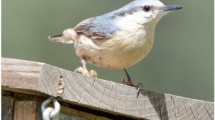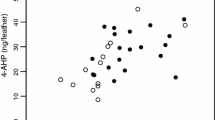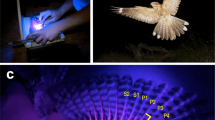Abstract
In several species, the rusty color of hair or feathers is due to pheomelanin pigments, whose adaptive function is unknown. Pheomelanin may be costly because it is phototoxic and its production consumes a key intracellular antioxidant. Pheomelanin-based traits are, however, positively associated with individual quality in several bird species, where they have thus been suggested to have evolved through sexual selection. Here we investigated the signaling potential of the pheomelanin-based coloration of the crown feathers in the blue petrel. Although this pelagic seabird is nocturnal at the breeding colony and breeds within deep burrows, it might use visual communication when settled on the water during daytime. We tested the correlation between crown color and several fitness-related traits, and we found that higher-quality females displayed less-orange crown than poorer-quality females. This result is inconsistent with an adaptive function of pheomelanin-based coloration in inter-, or intra-, sexual selection in females. We suggest that it might, however, be in line with a signaling function of eumelanin-based coloration, if inter-individual variations in orange coloration are mainly due to eumelanin-to-pheomelanin ratio, rather than to pheomelanin quantity. In contrast to females, we did not find strong evidence for associations between melanin-based coloration and individual quality in males, suggesting sex-specific selective pressures on melanin-based traits in this species.





Similar content being viewed by others
References
Arai E, Hasegawa M, Nakamura M, Wakamatsu K (2015) Male pheomelanin pigmentation and breeding onset in barn swallows Hirundo rustica gutturalis. J Ornithol 156:419–427
Arai E, Hasegawa M, Wakamatsu K, Ito S (2018) Males with more pheomelanin have a lower oxidative balance in Asian barn swallows (Hirundo rustica gutturalis). Zool Sci 35:505–514
Arai E, Hasegawa M, Sato M, Sakai H, Ito S, Wakamatsu K (2019) Eumelanin levels in rufous feathers explain plasma testosterone levels and survival in swallows. Ecol Evol 9:2755–2764
Ariyomo TO, Watt PJ (2013) Disassortative mating for boldness decreases reproductive success in the guppy. Behav Ecol 24:1320–1326
Bates D, Mächler M, Bolker B, Walker S (2014) Fitting linear mixed-effects models using lme4. arXiv:1406.5823
Benedetto J-P, Ortonne J-P, Voulot C, Khatchadourian C, Prota G, Thivolet J (1982) Role of thiol compounds in mammalian melanin pigmentation. II. Glutathione and related enzymatic activities. J Investig Dermatol 79:422–424
Bize P, Devevey G, Monaghan P, Doligez B, Christe P (2008) Fecundity and survival in relation to resistance to oxidative stress in a free-living bird. Ecology 89:2584–2593
Bortolotti GR, González LM, Margalida A, Sánchez R, Oria J (2008) Positive assortative pairing by plumage colour in Spanish imperial eagles. Behav Process 78:100–107
Bretagnolle V (1996) Acoustic communication in a group of nonpasserine birds, the petrels. Ecol Evol Acoust Commun Birds 160:177
Brooke MDL (1989) Determination of the absolute visual threshold of a nocturnal seabird, the common diving petrel Pelecanoides urinatrix. Ibis 131:290–294
Budden AE, Dickinson JL (2009) Signals of quality and age: the information content of multiple plumage ornaments in male western bluebirds Sialia mexicana. J Avian Biol 40:18–27
Chaurand T, Weimerskirch H (1994a) Incubation routine, body mass regulation and egg neglect in the blue petrel Halobaena caerulea. Ibis 136:285–290
Chaurand T, Weimerskirch H (1994b) The regular alternation of short and long foraging trips in the blue petrel Halobaena caerulea: a previously undescribed strategy of food provisioning in a pelagic seabird. J Anim Ecol 63:275–282
Cohen Alan A, McGraw Kevin J, Wiersma P, Williams Joseph B, Robinson WD, Robinson Tara R et al (2008) Interspecific associations between circulating antioxidant levels and life-history variation in birds. Am Nat 172:178–193
Core Team R (2017) R: A language and environment for statistical computing. R Foundation for Statistical Computing, Vienna
Costantini D (2008) Oxidative stress in ecology and evolution: lessons from avian studies. Ecol Lett 11:1238–1251
Costantini D, Bonadonna F (2010) Patterns of variation of serum oxidative stress markers in two seabird species. Polar Res 29:30–35
Costantini D, Coluzza C, Fanfani A, Dell’Omo G (2007) Effects of carotenoid supplementation on colour expression, oxidative stress and body mass in rehabilitated captive adult kestrels (Falco tinnunculus). J Comp Physiol B 177:723–731
Ducrest A-L, Keller L, Roulin A (2008) Pleiotropy in the melanocortin system, coloration and behavioural syndromes. Trends Ecol Evol 23:502–510
El-Khairy L, Vollset SE, Refsum H, Ueland PM (2003) Plasma total cysteine, pregnancy complications, and adverse pregnancy outcomes: the Hordaland Homocysteine Study. Am J Clin Nutr 77:467–472
Furumura M, Sakai C, Abdel-Malek Z, Barsh GS, Hearing VJ (1996) The interaction of agouti signal protein and melanocyte stimulating hormone to regulate melanin formation in mammals. Pigment Cell Res 9:191–203
Galván I (2017) Condition-dependence of pheomelanin-based coloration in nuthatches Sitta europaea suggests a detoxifying function: implications for the evolution of juvenile plumage patterns. Sci Rep 7:9138
Galván I (2018) Predation risk determines pigmentation phenotype in nuthatches by melanin-related gene expression effects. J Evol Biol 31:1760–1771
Galván I, Alonso-Alvarez C (2009) The expression of melanin-based plumage is separately modulated by exogenous oxidative stress and a melanocortin. Proc R Soc B 276:3089–3097
Galván I, Alonso-Alvarez C (2017) Individual quality via sensitivity to cysteine availability in a melanin-based honest signaling system. J Exp Biol 220:2825–2833
Galván I, Møller AP (2009) Different roles of natural and sexual selection on senescence of plumage colour in the barn swallow. Funct Ecol 23:302–309
Galván I, Solano F (2009) The evolution of eu-and pheomelanic traits may respond to an economy of pigments related to environmental oxidative stress. Pigment Cell Melanoma Res 22:339–342
Galván I, Solano F (2016) Bird integumentary melanins: biosynthesis, forms, function and evolution. Int J Mol Sci 17:520
Galván I, Alonso-Alvarez C, Negro JJ (2012a) Relationships between hair melanization, glutathione levels, and senescence in wild boars. Physiol Biochem Zool 85:332–347
Galván I, Ghanem G, Møller AP (2012b) Has removal of excess cysteine led to the evolution of pheomelanin? Pheomelanogenesis as an excretory mechanism for cysteine. BioEssays 34:565–568
Galván I, Jorge A, Ito K, Tabuchi K, Solano F, Wakamatsu K (2013) Raman spectroscopy as a non-invasive technique for the quantification of melanins in feathers and hairs. Pigment Cell Melanoma Res 26:917–923
Galván I, Inácio Â, Romero-Haro AA, Alonso-Alvarez C (2017) Adaptive downregulation of pheomelanin-related Slc7a11 gene expression by environmentally induced oxidative stress. Mol Ecol 26:849–858
Gasparini J, Bize P, Piault R, Wakamatsu K, Blount JD, Ducrest AL et al (2009) Strength and cost of an induced immune response are associated with a heritable melanin-based colour trait in female tawny owls. J Anim Ecol 78:608–616
Gerstenblith MR, Shi J, Landi MT (2010) Genome-wide association studies of pigmentation and skin cancer: a review and meta-analysis. Pigment Cell Melanoma Res 23:587–606
Hau M, Haussmann MF, Greives TJ, Matlack C, Costantini D, Quetting M et al (2015) Repeated stressors in adulthood increase the rate of biological ageing. Front Zool 12:4
Herborn KA, Daunt F, Heidinger BJ, Granroth-Wilding HMV, Burthe SJ, Newell MA et al (2016) Age, oxidative stress exposure and fitness in a long-lived seabird. Funct Ecol 30:913–921
Hill GE (2014) Cellular respiration: the nexus of stress, condition, and ornamentation. Integr Comp Biol 54:645–657
Holveck M-J, Riebel K (2009) Low-quality females prefer low-quality males when choosing a mate. Proc R Soc B 277:153–160
Indykiewicz P, Podlaszczuk P, Surmacki A, Kudelska K, Kosicki J, Kamiński M et al (2017) Scale-of-choice effect in the assortative mating by multiple ornamental and non-ornamental characters in the black-headed gull. Behav Ecol Sociobiol 71:183
Ito S, Wakamatsu K (2003) Quantitative analysis of eumelanin and pheomelanin in humans, mice, and other animals: a comparative review. Pigment Cell Res 16:523–531
Jacquin L, Lenouvel P, Haussy C, Ducatez S, Gasparini J (2011) Melanin-based coloration is related to parasite intensity and cellular immune response in an urban free living bird: the feral pigeon Columba livia. J Avian Biol 42:11–15
Jawor JM, Breitwisch R (2003) Melanin ornaments, honesty, and sexual selection. Auk 120:249–265
Jiang Y, Bolnick DI, Kirkpatrick M (2013) Assortative mating in animals. Am Nat 181:E125–E138
Jones DP (2006) Redefining oxidative stress. Antioxid Redox Signal 8:1865–1879
Karell P, Ahola K, Karstinen T, Valkama J, Brommer JE (2011) Climate change drives microevolution in a wild bird. Nat Commun 2:208
Kingsolver JG, Pfennig DW (2004) Individual-level selection as a cause of Copes’ rule of phyletic size increase. Evolution 58:1608–1612
Kinnaert E, Duez P, Morandini R, Dubois J, Van Houtte P, Ghanem G (2004) Cysteine but not glutathione modulates the radiosensitivity of human melanoma cells by affecting both survival and DNA damage. Pigment Cell Res 17:275–280
Krist M (2011) Egg size and offspring quality: a meta-analysis in birds. Biol Rev 86:692–716
Laucht S, Kempenaers B, Dale J (2010) Bill color, not badge size, indicates testosterone-related information in house sparrows. Behav Ecol Sociobiol 64:1461–1471
Le Pape E, Wakamatsu K, Ito S, Wolber R, Hearing VJ (2008) Regulation of eumelanin/pheomelanin synthesis and visible pigmentation in melanocytes by ligands of the melanocortin 1 receptor. Pigment Cell Melanoma Res 21:477–486
Leclaire S, Bourret V, Wagner RH, Hatch SA, Helfenstein F, Chastel O et al (2011) Behavioral and physiological responses to male handicap in chick-rearing black-legged kittiwakes. Behav Ecol 22:1156–1165
Lu D, Willard D, Patel IR, Kadwell S, Overton L, Kost T et al (1994) Agouti protein is an antagonist of the melanocyte-stimulating-hormone receptor. Nature 371:799
Mariette MM, Griffith SC (2015) The adaptive significance of provisioning and foraging coordination between breeding partners. Am Nat 185:270–280
McGraw KJ (2006) Mechanics of melanin-based coloration. In: Hill GE, McGraw KJ (eds) Bird coloration. I. Mechanisms and measurements. Harvard University Press, Cambridge
Metcalfe NB, Alonso-Alvarez C (2010) Oxidative stress as a life-history constraint: the role of reactive oxygen species in shaping phenotypes from conception to death. Funct Ecol 24:984–996
Mitkus M, Nevitt GA, Danielsen J, Kelber A (2016) Vision on the high seas: spatial resolution and optical sensitivity in two procellariiform seabirds with different foraging strategies. J Exp Biol 219:3329–3338
Mitra D, Luo X, Morgan A, Wang J, Hoang MP, Lo J et al (2012) An ultraviolet-radiation-independent pathway to melanoma carcinogenesis in the red hair/fair skin background. Nature 491:449
Morales-Guerrero B, Gendron D, Martinez-Levasseur LM, Acevedo-Whitehouse K (2019) Blue whale (Balaenoptera musculus) skin contains eumelanin and pheomelanin. Aquat Mamm 45:88–98
Nachman MW, Hoekstra HE, D’Agostino SL (2003) The genetic basis of adaptive melanism in pocket mice. Proc Natl Acad Sci USA 100:5268–5273
Napolitano A, Panzella L, Monfrecola G, d’Ischia M (2014) Pheomelanin-induced oxidative stress: bright and dark chemistry bridging red hair phenotype and melanoma. Pigment Cell Melanoma Res 27:721–733
Negro JJ, Bortolotti GR, Mateo R, García IM (2009) Porphyrins and pheomelanins contribute to the reddish juvenal plumage of black-shouldered kites. Comp Biochem Physiol B 153:296–299
Olney JW, Ho O-L (1970) Brain damage in infant mice following oral intake of glutamate, aspartate or cysteine. Nature 227:609–611
Orth MW, Bai Y, Zeytun IH, Cook ME (1992) Excess levels of cysteine and homocysteine induce tibial dyschondroplasia in broiler chicks. J Nutr 122:482–487
Panzella L, Leone L, Greco G, Vitiello G, D’Errico G, Napolitano A et al (2014) Red human hair pheomelanin is a potent pro-oxidant mediating UV-independent contributory mechanisms of melanomagenesis. Pigment Cell Melanoma Res 27:244–252
Pascual P, Pedrajas JR, Toribio F, López-Barea J, Peinado J (2003) Effect of food deprivation on oxidative stress biomarkers in fish (Sparus aurata). Chem Biol Interact 145:191–199
Peig J, Green AJ (2009) New perspectives for estimating body condition from mass/length data: the scaled mass index as an alternative method. Oikos 118:1883–1891
Pérez-Rodríguez L, Viñuela J (2008) Carotenoid-based bill and eye ring coloration as honest signals of condition: an experimental test in the red-legged partridge (Alectoris rufa). Naturwissenschaften 95:821–830
Phillips RA, Bearhop S, Mcgill RAR, Dawson DA (2009) Stable isotopes reveal individual variation in migration strategies and habitat preferences in a suite of seabirds during the nonbreeding period. Oecologia 160:795–806
Potti J, Montalvo S (1991) Male colour variation in Spanish pied flycatchers Ficedula hypoleuca. Ibis 133:293–299
Rodríguez-Martínez S, Márquez R, Inácio Â, Galván I (2019) Changes in melanocyte RNA and DNA methylation favour pheomelanin synthesis and may avoid systemic oxidative stress after dietary cysteine supplementation in birds. Mol Ecol 28:1030–1042
Roulin A (2003) Geographic variation in sexual dimorphism in the barn owl Tyto alba: a role for direct selection or genetic correlation? J Avian Biol 34:251–258
Roulin A, Altwegg R (2007) Breeding rate is associated with pheomelanism in male and with eumelanism in female barn owls. Behav Ecol 18:563–570
Roulin A, Ducret B, Ravussin P-A, Altwegg R (2003) Female colour polymorphism covaries with reproductive strategies in the tawny owl Strix aluco. J Avian Biol 34:393–401
Roulin A, Almasi B, Meichtry-Stier KS, Jenni L (2011) Eumelanin- and pheomelanin-based colour advertise resistance to oxidative stress in opposite ways. J Evol Biol 24:2241–2247
Rowe KM, Weatherhead PJ (2011) Assortative mating in relation to plumage traits shared by male and female American robins. The Condor 113:881–889
Safran RJ, McGraw KJ (2004) Plumage coloration, not length or symmetry of tail-streamers, is a sexually selected trait in North American barn swallows. Behav Ecol 15:455–461
Schulte-Hostedde AI, Zinner B, Millar JS, Hickling GJ (2005) Restitution of mass–size residuals: validating body condition indices. Ecology 86:155–163
Siefferman L, Hill GE (2003) Structural and melanin coloration indicate parental effort and reproductive success in male eastern bluebirds. Behav Ecol 14:855–861
Singaravelan N, Pavlicek T, Beharav A, Wakamatsu K, Ito S, Nevo E (2010) Spiny mice modulate eumelanin to pheomelanin ratio to achieve cryptic coloration in “Evolution Canyon,” Israel. PLoS ONE 5:e8708
Spoon TR, Millam JR, Owings DH (2006) The importance of mate behavioural compatibility in parenting and reproductive success by cockatiels, Nymphicus hollandicus. Anim Behav 71:315–326
Stevens M, Cuthill IC (2005) The unsuitability of html-based colour charts for estimating animal colours—a comment on Berggren and Merilä (2004). Front Zool 2:14
Stevens M, Stoddard MC, Higham JP (2009) Studying primate color: towards visual system-dependent methods. Int J Primatol 30:893–917
Tickell WLN (1962) The dove prion, Pachyptila desolata Gmelin. HMSO, London
Vágási CI, Pap PL, Barta Z (2010) Haste makes waste: accelerated molt adversely affects the expression of melanin-based and depigmented plumage ornaments in house sparrows. PLoS ONE 5:e14215
van Franeker JA, van den Brink NW, Bathmann UV, Pollard RT, de Baar HJW, Wolff WJ (2002) Responses of seabirds, in particular prions (Pachyptila sp.), to small-scale processes in the Antarctic Polar Front. Deep Sea Res Part 2 Top Stud Oceanogr 49:3931–3950
Vergara P, Fargallo JA, Martinez-Padilla J, Lemus JA (2009) Inter-annual variation and information content of melanin-based coloration in female Eurasian kestrels. Biol J Linn Soc 97:781–790
Verhulst S, Nilsson J-Å (2008) The timing of birds’ breeding seasons: a review of experiments that manipulated timing of breeding. Philos Trans R Soc Lond B Biol Sci 363:399–410
Warham J (1996) The behaviour, population biology and physiology of the petrels. Academic Press, London
Wasselin T, Zahn S, Maho YL, Dorsselaer AV, Raclot T, Bertile F (2014) Exacerbated oxidative stress in the fasting liver according to fuel partitioning. Proteomics 14:1905–1921
Wilson AJ, Nussey DH (2010) What is individual quality? An evolutionary perspective. Trends Ecol Evol 25:207–214
Zahavi A (1975) Mate selection—selection for a handicap. J Theor Biol 53:205–214
Acknowledgements
We thank Joris Laborie for his help during fieldwork, and Felipe Ramon-Portugal and Gilles Espinasse for their help during the first stage of pigment characterization. This work was supported by the Institut Polaire Français Paul-Emile Victor (IPEV, Program No. 354 to F.B.), and by a PDOC grant from the Agence Nationale de la Recherche (No. ANR-13-PDOC-0002 to S.L.). This study was approved by the French Ethical Committee (APAFIS#: 9496-201707131540776v2), after favorable recommendation by the “comité d’éthique pour l’expérimentation animale - Languedoc-Roussillon”, and the ethical committees of “réserve naturelle des Terres Australes et Antarctiques Françaises (TAAF)” and of “Institut Polaire Rrançais Paul-Emile Victor (IPEV)”.
Author information
Authors and Affiliations
Corresponding author
Ethics declarations
Conflict of interest
The authors declare no conflict of interest.
Additional information
Publisher's Note
Springer Nature remains neutral with regard to jurisdictional claims in published maps and institutional affiliations.
Electronic supplementary material
Below is the link to the electronic supplementary material.
Rights and permissions
About this article
Cite this article
Leclaire, S., Perret, S., Galván, I. et al. Pheomelanin-based coloration is related to individual quality and oxidative stress in blue petrels. Evol Ecol 33, 873–887 (2019). https://doi.org/10.1007/s10682-019-10010-7
Received:
Accepted:
Published:
Issue Date:
DOI: https://doi.org/10.1007/s10682-019-10010-7




